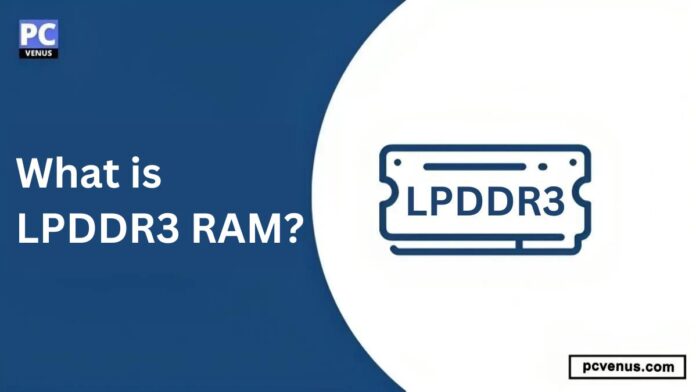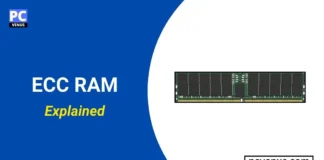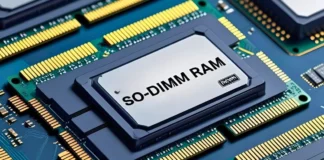The earlier RAM was slow and also consumed energy, so there was always a concern about battery life in all devices. To address this concern, LPDDR (Low Power Double Data Rate) RAM was introduced, with many versions released since then. LPDDR3 RAM, launched in 2013, quickly gained popularity due to its faster speed compared to its predecessor.
It uses the same interface, so there is no need for a new architecture for this RAM. It also comes with 50% more bandwidth, from 8.5GB/s to 12.8GB/s, and the adoption of ODT (On-Die Termination), which improves the system performance. LPDDR3 also consumes much less power and comes with greater capacity than LPDDR2.
In this article, we will discuss LPDDR3 RAM so that you can know whether this RAM is better than all its previous RAMs. If you are planning to buy this RAM, then this article will give you complete information so that you will not have any problem in choosing one.
What is LPDDR3 RAM

Mobile DDR, also known as MDDR, low power DDR, or LPDDR, is a type of double data rate synchronous DRAM used in mobile, tablet, and portable devices. LPDDR3 RAM stands for Low Power Double Data Rate 3 Synchronous Dynamic Random-Access Memory.
LPDDR3 RAM is the memory that mobile, tablet, and portable devices use, offering better energy efficiency and faster data transfer rates than its predecessor RAM. Improving the per-pin transfer rate has increased data speed. Along with a better data transfer rate, it also consumes less energy than LPDDR2 RAM. It operates at around 1.2V, while LPDDR2 RAM operates at 1.8V.
Advantages of LPDDR3 RAM
Power Efficiency
One of the biggest advantages of LPDDR3 RAM is its energy efficiency, as it operates at a lower voltage than its predecessor, LPDDR2 RAM, which significantly reduces battery consumption in mobile and portable devices.
Due to its low battery consumption, it is mostly used in portable devices, as battery life is important for all these devices. It has features like Partial Array Self-Refresh (PASR) and Deep Power Down (DPD) mode. Advanced power-saving features help reduce power usage when RAM is not actively being accessed.
Higher Data Transfer Rate
Its bandwidth is also more than LPDDR2 RAM due to which it transfers data very fast. It transfers data at a speed of approximately 1600MT/s, which is twice the speed of 800 MT/s of LPDDR2 RAM. Due to its high data transfer rate, there is faster communication between the RAM and the processor of the device, which increases the overall performance of the system. Its high bandwidth ensures smooth gaming, multitasking, and multimedia playback.
Lower Cost
LPDDR3 RAM comes with many advanced features like better data transfer speed, low power consumption, error correction, and more. It is also cheaper than LPDDR2 RAM. Due to its good performance and low price, it is widely used in mobile and portable devices. Its affordability does not compromise its performance, making it a popular choice.
Compatibility and Scalability
It is compatible with the existing hardware and software ecosystem, due to which there is no problem in integrating it into various devices. The biggest advantage of its compatibility is that it is easily available in the market. Because of this feature, people like it highly, and it is widely supported by a wide range of mobile device manufacturers, chipset vendors, and system integrators.
It comes in a variety of capacities, allowing you to choose the right configuration depending on your needs. This flexibility makes LPDDR3 compatible with a range of devices, from entry-level smartphones to high-end tablets and ultraportable laptops. Makes it suitable for a wide range of applications.
LPDDR4 vs LPDDR3 vs LPDDR3X vs DDR3 vs LPDDR2, LPDDR1
| Feature | LPDDR4 | LPDDR3 | LPDDR3X | DDR3 | LPDDR2 | LPDDR1 |
|---|---|---|---|---|---|---|
| Purpose | Mobile devices, ultrabooks, low-power systems | Mobile devices, ultrabooks, low-power systems | Mobile devices, ultrabooks, low-power systems | Desktops, laptops, low-power systems | Mobile devices, low-power systems | Mobile devices, low-power systems |
| Data Rate | Up to 4266 Mbps | Up to 2133 Mbps | Up to 4266 Mbps | Up to 1866 Mbps | Up to 1066 Mbps | Up to 400 Mbps |
| Bandwidth | Up to 34.1 GB/s | Up to 17 GB/s | Up to 34.1 GB/s | Up to 14.9 GB/s | Up to 8.5 GB/s | Up to 3.2 GB/s |
| Operating Frequency | Up to 2133 MHz | Up to 1066 MHz | Up to 2133 MHz | Up to 1600 MHz | Up to 533 MHz | Up to 200 MHz |
| Voltage Modes | Single voltage (1.1V) | Single voltage (1.35V) | Single voltage (1.1V) | Single voltage (1.5V) | Single voltage (1.8V) | Single voltage (2.5V) |
| Channels | 2x 32-bit channels | 2x 64-bit channels | 2x 64-bit channels | 2x 64-bit channels | 2x 64-bit channels | 2x 64-bit channels |
| Burst Length | 16 (per channel) | 8 (per channel) | 16 (per channel) | 8 (per channel) | 4 (per channel) | 2 (per channel) |
| Prefetch | 16n (per channel) | 8n (per channel) | 16n (per channel) | 8n (per channel) | 4n (per channel) | 2n (per channel) |
| Banks | 8 (standard bank structure) | 8 (standard bank structure) | 8 (standard bank structure) | 8 (standard bank structure) | 4 (standard bank structure) | 4 (standard bank structure) |
| Memory Densities | Up to 16GB per channel | Up to 8GB per channel | Up to 16GB per channel | Up to 16GB | Up to 4GB per channel | Up to 2GB per channel |
| Error Correction | On-die ECC | On-die ECC | On-die ECC | External ECC chip or integrated in memory controller | On-die ECC | No ECC |
| Form Factor | Smaller form factor, typically BGA packages | Smaller form factor, typically BGA packages | Smaller form factor, typically BGA packages | DIMM modules | DIMM modules | DIMM modules |
| Release Date | September 2014 | June 2007 | June 2007 | June 2007 | August 2003 | June 2000 |
What to consider when choosing LPDDR3 RAM?

There are many things to keep in mind while buying any LPDDR3 RAM.
Compatibility:
If you are buying RAM, then first of all, check the compatibility. Check whether the RAM you are buying is compatible with your motherboard or not, because LPDDR3 RAM is not compatible with all motherboards. If the RAM is not compatible with the motherboard, you will not be able to take advantage of the full potential of the RAM.
Speed:
LPDDR3 RAM comes with many configurations; hence, choose a RAM that has good speed because the speed of RAM affects the performance of the device. If the RAM speed is good, then your work will be done quickly.
Budget:
While choosing RAM, also keep the budget in mind because LPDDR3 is a new-age RAM that is a little more expensive than all the previous-generation RAMs. Therefore, invest in RAM only after identifying your needs.
Capacity:
LPDDR3 RAM comes with different capacities, so first, determine how much capacity RAM you need. If you only do daily tasks like watching videos, playing YouTube, and browsing social media, then 8GB LPDDR3 RAM will be enough for you. If you do intensive tasks like streaming, gaming, and video editing, you should choose at least 16 GB RAM.
Energy Efficiency:
Look for RAM that gives you better performance but consumes less energy. LPDDR3 RAM consumes very little power without compromising performance. Therefore, before choosing any other RAM, check its effect on battery life.
Brand Reputation:
When picking RAM, focus on the brand and quality. Some companies make better RAM than others, so choose one from a good brand. Better brands use good materials, which means their RAM works better and lasts longer.
Also Read
- Best 8GB RAM Laptops
- What is LPDDR4 RAM: Everything You Need to Know
- What is LPDDR5 RAM: Everything You Need to Know
FAQs
What does LPDDR3 RAM stand for?
LPDDR3 stands for Low-Power Double Data Rate 3. “Low power” means it consumes less energy, which is important for battery life in portable gadgets. LPDDR3 is a type of memory used in devices such as laptops, smartphones, and tablets.
Can LPDDR3 RAM be upgraded or replaced?
No, LPDDR3 RAM cannot be easily upgraded or replaced by the user. It is soldered directly onto the main board of the device during manufacturing.
So, if your device has soldered LPDDR3 RAM, you cannot upgrade it. However, some laptops allow you to replace the RAM module, but you will have to check the compatibility of your specific device.
Is LPDDR3 RAM backward compatible with older LPDDR generations?
No, LPDDR3 RAM is not compatible with older generations like LPDDR2 or LPDDR1. Older generations of memory have different technologies, so you can’t use LPDDR3 RAM in a device designed for the older LPDDR version. Newer LPDDR versions are also not compatible with LPDDR3.
Final Words
LPDDR3 RAM is an improvement over older versions like LPDDR2 and LPDDR1. It performs better and uses less energy. This makes it ideal for mobile, tablet, and portable devices, where having a good battery life is crucial.
Its data transfer rate is also better than LPDDR2, resulting in better overall system performance. The best part is that it is compatible with the existing hardware and software ecosystem so that it can be easily integrated into various devices. The biggest advantage of its compatibility is that it is easily available in the market, so you will not have to search much for it.




